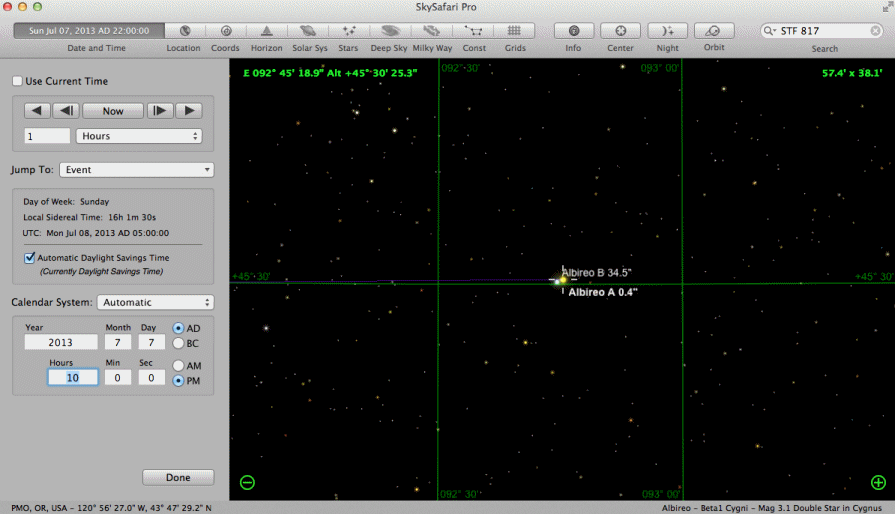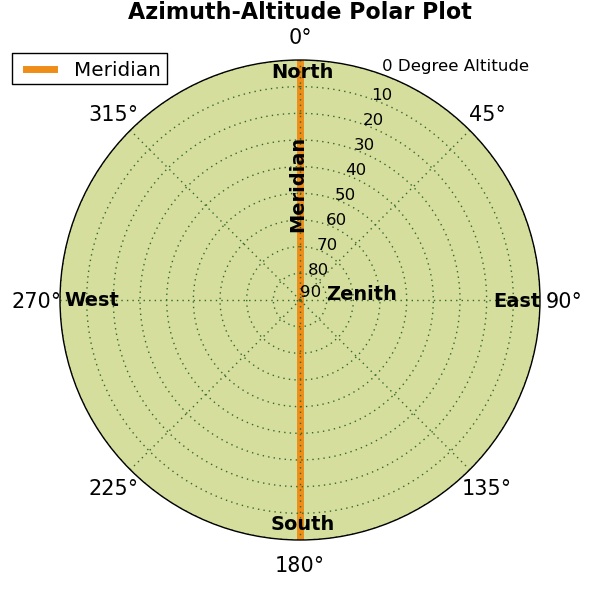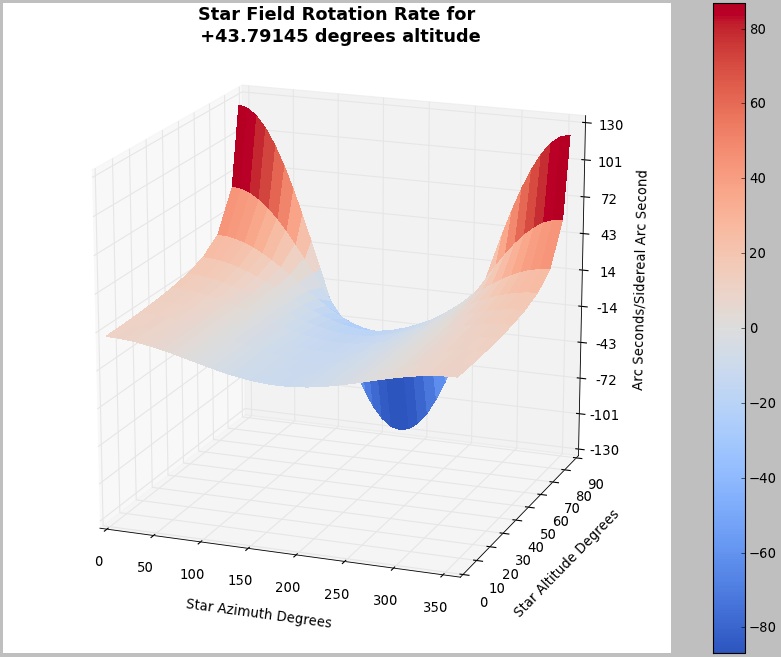<<PREVIOUS -
HOME -
CONTENTS -
NEXT>>
DOUBLE STARS INDEX -
![]()
Alt-Azimuth Field Rotation
Work in Progress

<<PREVIOUS -
HOME -
CONTENTS -
NEXT>>
DOUBLE STARS INDEX -
![]()

Motor driven alt-azimuth telescopes needs a field rotator for perfect exposures. For double star measurements the key question to be answered is with the double stars in the center of the image how long of an exposure can be taken before the field rotation affects the astrometric calibration of the image.
The above repeating animation shows the field rotation of Albireo double star in six hours from the evening of July 7, 2013 10 PM in one hour increments to the morning of July 8, 2013 4 AM at Pine Mountain Observatory, Oregon, USA. The green readout in the upper left corner of the sky chart shows the azimuth and altitude of Albireo. The field rotation rate is minimum at the beginning and ending times. The field rotation rate is maximum during the crossing of the meridian between 1 AM and 2 AM.
|
Time |
Albireo Azimuth |
Albireo Altitude |
Field Rotation Rate |
|
10 PM |
E 092° 45' 18.9" |
+45° 30' 25.3" |
-0.745 arc sec./sidereal sec. |
|
11 PM |
E 105° 17' 29.3" |
+56° 13' 4.9" |
-5.150 arc sec./sidereal sec. |
|
12 AM |
SE 123° 58' 11.9" |
+66° 6' 16.6" |
-14.977 arc sec./sidereal sec. |
|
1 AM |
SE 157° 10' 29.0" |
+73° 8' 28.1" |
-34.506 arc sec./sidereal sec. |
|
2 AM |
SW 203° 58' 39.3" |
+73° 1' 33.7" |
-33.982 arc sec./sidereal sec. |
|
3 AM |
SW 236° 40' 5.7" |
+65° 51' 48.2" |
-14.590 arc sec./sidereal sec. |
|
4 AM |
W 255° 5' 54.8" |
+55° 56' 17.6" |
-4.985 arc sec./sidereal sec. |
Enthought Canopy Express Python script to create the Albireo field rotation rate (FieldrotateV1.py.zip) and data file (StarData.csv)
The farther the double stars are from the center of the image the longer the length field rotation arc is in the image. Field rotation varies depending upon the altitude and azimuth of the double stars and the longitude and latitude of the observer.
For example, an alt-azimuth telescope on the equator pointed directly east or west will not see any field rotation as the stars rise vertically in the east towards the zenith. Only the alt-azimuth telescope altitude motor is used until it reaches the zenith. At exactly the zenith the alt-azimuth telescope azimuth motor rotates the telescope 180 degrees. Now the altitude motor reverses direction following the star to the western horizon. After the azimuth rotation at the zenith the image will have star arcs that are 180 degrees. Alt-azimuth tracking a object near the zenith results in large field rotation in the image for a alt-azimuth telescope without a field rotator.
Azimuth-Altitude Polar Plot
Azimuth-altitude polar plot represents the sky seen from a specific location and time. The azimuth starts at 0 degree north, increases to 90 degrees east, next is 180 degrees south, next is 270 degrees west and back to 360 north or 0 degrees north. Altitude starts at 0 degrees at the horizon and goes up to 90 degrees above your head which is called the zenith.

Enthought Canopy Express Python script to create the Azimuth-Altitude Polar Plot (AzAltPolarPlotV1.py.zip)
The reference line from the horizon at 0 degrees azimuth north through the zenith and down to 180 degrees azimuth south at the horizon is call the meridian. The star altitude is the greatest when it is on the meridian and it is south of the north celestial pole (NCP) for observers in the northern hemisphere. The NCP is on the meridian between 0 degrees azimuth north and the zenith. The north celestial pole altitude is the same value as the observers latitude. For example, Pine Mountain Observatory (PMO) latitude is +43.79145 degrees and the NCP altitude is +43.79145 degrees on the meridian at PMO. Therefore, at PMO NCP is at 0 degrees azimuth and +43.79145 degrees altitude. As time progresses stars move in arcs around the NCP as the Earth rotates. The stars make a complete circle around the NCP in one sidereal day.
Azimuth-Altitude Polar Plot
The Field Rotation Rate Plot for PMO at +43.79145 degree altitude. The Star altitude is 0, 10, 20, .. 80, 85 degrees. The star azimuth is 0, 10, 20, .. 340, 350, 360 degrees.

Enthought Canopy Express Python script to create the Field Rotation Rate Plot (simple_plot3.py.zip)
Angular Rate of Field Rotation Calculation
Angular rate of field rotation calculation depends upon the
Angular rate of field rotation = (angular rate of rotation of the Earth x cos(observer's latitude)) x cos(star azimuth) / cos(star altitude)
Angular Rate of Rotation of the Earth
The angular rate of rotation of the earth in reference to the stars is 360 degrees divided by the sidereal day. The mean sidereal day is 23 hours, 56 minutes, 4.0915 seconds. Sidereal day is 86164.0916 seconds long.
Observer's Constant for Pine Mountain Observatory, Oregon (Latitude: +43.79145, Longitude: -120.94083)
Links ![]()
References